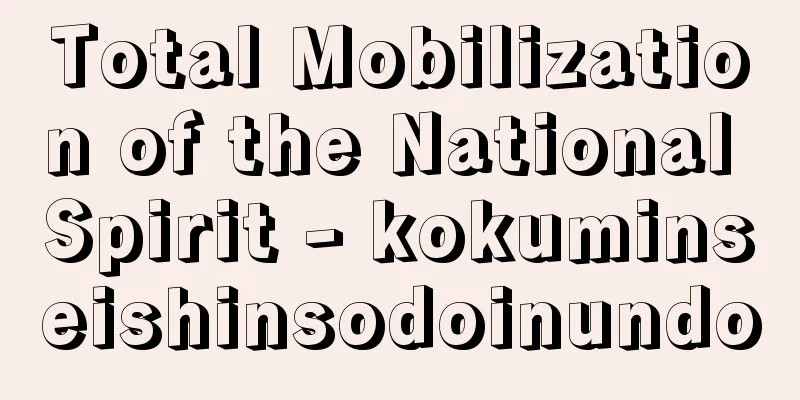Total Mobilization of the National Spirit - kokuminseishinsodoinundo

|
This was a government-sponsored national movement to encourage people to cooperate in the war effort, which began with the start of the Sino-Japanese War. It is sometimes abbreviated as "Seido." In August 1937, the first Konoe Fumimaro Cabinet decided on the "Outline for the Implementation of the Total Mobilization of the National Spirit," and in October of the same year, the Central Federation of the Total Mobilization of the National Spirit (chaired by Admiral Arima Ryokyo) was established under the slogan "National Unity, Loyalty to the Country, and Perseverance." Private organizations participated in the Central Federation, and notable people from the region participated in the local executive committees at the prefectural level, but there were no independent organizations at the municipal level, and the movement was carried out at the bottom by relying on government agencies. At first, it had a strong spiritual movement character, but it soon came to focus on cooperation with national economic policies during the long war, and gradually implemented measures such as encouraging people to increase savings and redeem government bonds and collecting metals more forcefully. In March 1939, the Central Committee for Total National Spiritual Mobilization was established, with the Minister of Education as chairman, and in August of the same year, the Kyoa Hōkō Day (the first of each month starting from September 1st of the same year) was established. In April 1940, the existing organizations were dissolved and the Total National Spiritual Mobilization Headquarters was established, but in October of the same year, this headquarters was absorbed into the Imperial Rule Assistance Association. This movement, which sought to mobilize the nation in terms of materials and labor by listing abstract virtues, created a system of wartime cooperation in the everyday lives of the people, but at the same time it was fraught with the contradiction of making it difficult to draw out the people's initiative. [Shiro Akazawa] [Reference] |Source: Shogakukan Encyclopedia Nipponica About Encyclopedia Nipponica Information | Legend |
|
日中全面戦争の開始に伴って始められた、国民の戦争協力を促す官製国民運動。「精動」と略されることもある。1937年(昭和12)8月第一次近衛文麿(このえふみまろ)内閣は「国民精神総動員実施要綱」を閣議決定し、同年10月「挙国一致、尽忠(じんちゅう)報国、堅忍(けんにん)持久」のスローガンのもとに国民精神総動員中央連盟(会長有馬良橘(ありまりょうきょう)海軍大将)を創設した。中央連盟には民間諸団体が参加し、道府県次元の地方実行委員会には地方名望家層が参加したが、市町村次元の独自組織はなく、底辺では行政機関に依存して運動が行われた。当初は精神運動の性格が強かったが、やがて長期戦下の経済国策への協力を中心とするようになり、貯蓄増加や国債消化の奨励、金属回収などがしだいに強力に実施されていった。39年3月には文部大臣を委員長とする国民精神総動員中央委員会が設置され、同年8月には興亜奉公日(同年9月1日より毎月1日)が設定され、40年4月には従来の組織を解消して国民精神総動員本部がつくられるが、同本部も同年10月には大政翼賛会に吸収された。 抽象的な徳目を並べて物資と労力の面で国民動員を図ったこの運動は、国民の日常生活面での戦争協力体制を築き上げた反面、国民の自発性を引き出すことが困難であるという矛盾を抱えていた。 [赤澤史朗] [参照項目] |出典 小学館 日本大百科全書(ニッポニカ)日本大百科全書(ニッポニカ)について 情報 | 凡例 |
<<: National Institute of Spiritual Culture
>>: Imperial Proclamation for the Revitalization of the National Spirit
Recommend
Medici, Francesco I de' (English spelling)
… [Hideo Katayama]. … *Some of the terminology th...
Age - Rank
〘Noun〙 (also "Nenjaku")① The right permi...
Electron
...This phenomenon has been known empirically for...
Kayado Hijiri
...It is known that Karikaya Doshin and Sekidomar...
Territorialismus (religionis)
In medieval Europe, the idea that the lord of a te...
Nepal - Nepal (English spelling)
A country in South Asia, in the central Himalayas...
Children's activities - tong xing (English)
In China, this refers to the members of a Buddhist...
Plymouth Colony - New Plymouth Colony
The first colony in New England (present-day easte...
Economizer - Economizer
… [Configuration and Efficiency] The main parts o...
Chicago Daily Tribune
…American daily newspaper. It was founded in 1847...
God's Mask - Shinmen
Old Noh masks such as Okina masks and various demo...
Cai Lun - Sairin
A Chinese eunuch in the middle of the Eastern Han...
Nuclear heat utilization
Of the energy required by society, heat accounts f...
Calculation amount - calculation amount
There are two types of time complexity and space c...
Tyler, E. (English spelling) TylerE
...However, the movement quickly died down when f...









